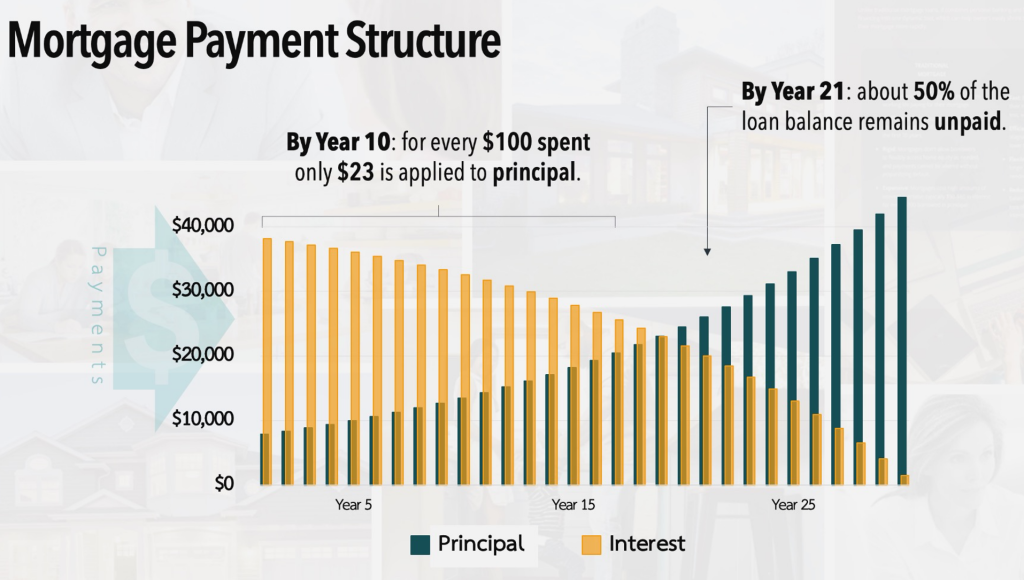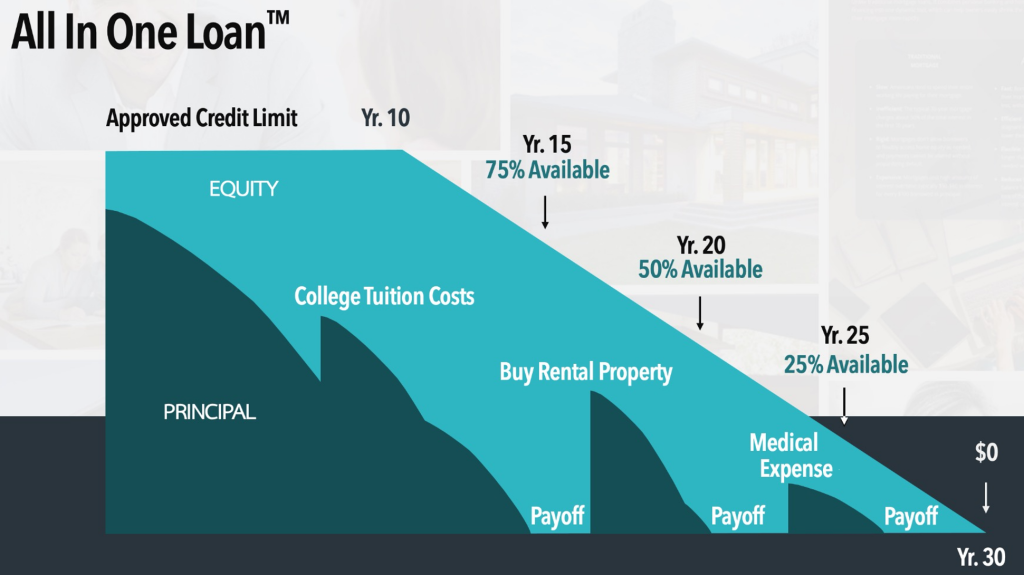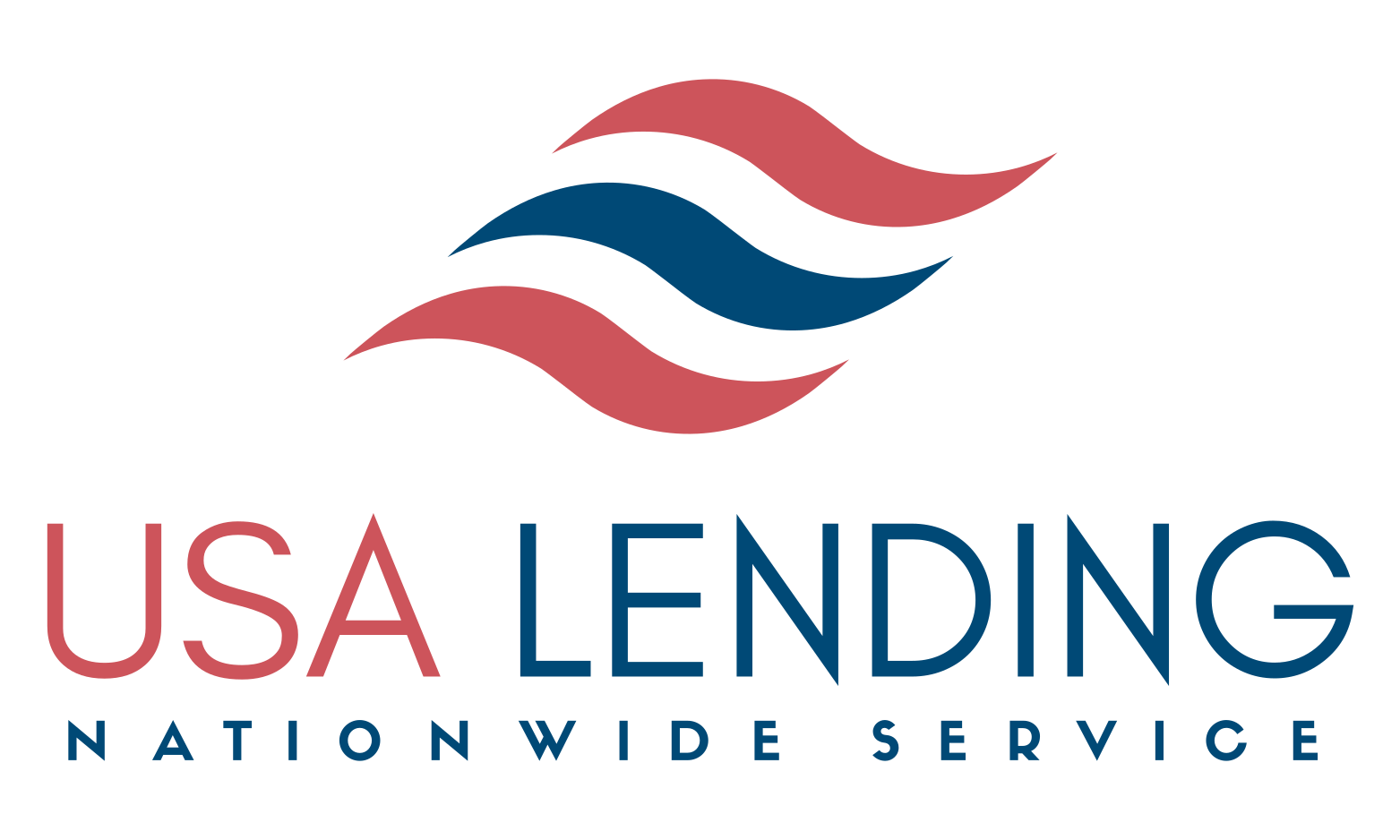When you finance a home or any other property, the first hurdle that often comes…
All In One Loan: A Comprehensive Guide for Borrowers
Emergence of the All In One Loan
In response to the limitations of traditional mortgages, the All-In-One Loan concept has gained traction. This innovative home financing approach gives homeowners greater control over their mortgage and financial situation. By combining the features of a traditional mortgage with the fluidity of a transactional bank account, All-In-One Mortgages represent a significant shift in how homeowners can manage their most important financial liability.
Overview of Mortgage Landscape
The traditional mortgage landscape has long been dominated by conventional loan structures, typically characterized by fixed or adjustable interest rates, a set repayment term (often 15 or 30 years), and a specific amortization schedule. While familiar and predictable, these traditional mortgages are designed to favor the bank or financing institution because the loan front-loads interest rather than helping the Borrower pay down the principal owed on the loan. As the financial world evolves, so does the need for more dynamic and adaptable mortgage solutions. This need for innovation has led to the development of alternative mortgage products that offer more flexibility and potential financial benefits.
In traditional fixed-rate mortgages, the repayment structure is on an amortization schedule that front-loads interest payments. Front-loading interest means that a more significant portion of each monthly payment is allocated to interest during the initial years of the mortgage term rather than reducing the principal amount. Consequently, homeowners often find that they have paid off only a tiny portion of the principal balance in the first five, seven, or even ten years of their mortgage term. The miniscule principal reduction is counterintuitive for borrowers, who expect their payments to contribute more significantly to reducing the loan’s principal balance. The amortization schedule ensures that the interest calculated based on the initial loan amount is covered in the early stages of the mortgage, gradually shifting the payment structure over time to pay down more of the principal as the interest obligation decreases.

Understanding All In One Mortgages
Definition and Mechanics an All In One Loan
An All-In-One Mortgage integrates the functions of a mortgage loan and a checking account into a single financial product. It allows homeowners to use their income to offset their mortgage balance daily, reducing the interest accrued over time. This type of mortgage operates on a simple yet effective principle: each deposit made into the account, whether a salary, bonus, or other income, immediately reduces the outstanding principal. This reduction in principal consequently lowers the amount of interest calculated because the Lender calculates interest on the daily balance.
Primary Benefits of All In One Mortgages
The primary advantage of an All-In-One Mortgage is its potential to save significant amounts on interest payments. By consistently lowering the principal balance, a Borrower can substantially reduce the overall interest cost over the life of the loan. Additionally, these mortgages provide increased flexibility compared to traditional loans, as a Borrower can withdraw the equity in the home to pay expenses or make investments, similar to a checking account. This feature particularly appeals to homeowners who want access to their funds and to maintain liquidity.
Comparison: All In One Mortgages vs. Traditional Mortgages
Payment Structure
Traditional mortgages usually have a fixed monthly payment that applies first to interest and then to the principal. This structure often means that during the initial years of the mortgage, a significant portion of each payment goes towards interest, with only a tiny fraction reducing the principal. In contrast, the All-In-One Mortgage’s flexible structure allows more of the homeowner’s income to directly reduce the principal balance, potentially leading to quicker equity build-up and overall interest savings.
Interest Calculation
How the All-In-One Mortgage calculates interest is fundamentally different from traditional mortgages. While conventional mortgages calculate interest based on the loan’s remaining balance, All-In-One Mortgages calculate interest on the average daily balance. Every time a Borrower deposits cash into the All-In-One account, those funds are swept directly onto the outstanding mortgage balances. Sweeping those funds reduces the loan balance on which the Lender calculates the interest, potentially leading to significant long-term savings.
The Evolution of Mortgage Management
Innovative Features
One of the most notable features of the All-In-One Mortgage is the direct impact of income deposits on the loan balance. This feature provides a proactive approach to mortgage management, unlike the reactive nature of traditional mortgages, where a Borrower makes payments according to a predetermined schedule. Moreover, the withdrawal options available in All-In-One Mortgages offer homeowners the flexibility to access their funds when needed, without secondary loans or credit lines.
Financial Planning and Wealth Building
All-In-One mortgages are not just about managing debt but also are powerful tools for financial planning and wealth building. By efficiently managing the mortgage, homeowners can free up funds that would otherwise go towards interest payments. This efficiency can be redirected towards investments, savings, or other financial goals, aligning with a comprehensive strategy for wealth accumulation and financial security.
Navigating the Pros and Cons of an All In One Loan
Advantages and All In One Mortgage
The All-In-One Mortgage offers a range of benefits that cater to the modern homeowner’s financial needs:
- Quicker Equity Build-Up: By applying income directly to the mortgage principal, homeowners can build equity faster than traditional mortgages.
- Interest Savings: The unique structure can lead to substantial interest savings over the life of the loan because the Lender calculates interest on a reduced principal.
- Increased Financial Flexibility: The ability to easily access home equity and integrate mortgage and banking features offer unparalleled financial flexibility.
Drawbacks of an All In One Loan
However, there are certain risks and downsides to consider:
- Variable Interest Rates: These mortgages often come with variable rates, which can increase over time, potentially offsetting some interest savings.
- Financial Discipline Requirement: Success with an All-In-One Mortgage relies heavily on disciplined financial management, making it less suitable for those with fluctuating incomes or poor budgeting habits.
All-In-One Mortgages and Refinancing: A Comparison
Refinancing Basics
Refinancing involves swapping your current mortgage with a new loan, typically to benefit from lower interest rates, change loan terms, or access equity. The process can lead to potential savings or cash-out options but often involves appraisal, closing costs, and possible loan term extensions.
Comparative Analysis
While refinancing and All-In-One Mortgages can reduce interest payments and provide equity access, the All-In-One option offers a more dynamic approach. Unlike refinancing, a one-time transaction, an All-In-One Mortgage continuously adapts to the homeowner’s financial inputs, potentially offering more significant long-term benefits.
All-In-One Mortgage vs. Home Equity Line of Credit (HELOC)
Understanding HELOC
Secured against your home’s equity, a Home Equity Line of Credit (HELOC) is a revolving credit line. It offers flexibility to borrow as needed but typically involves a separate payment from the primary mortgage.
Comparative Differences
The significant difference lies in the integration of features. While a HELOC is a separate product often used alongside a primary mortgage, an All-In-One Mortgage consolidates mortgage and credit line features. This integration can provide more efficient interest savings and financial management than managing two separate products like a mortgage and a HELOC.
Suitability: Is an All-In-One Mortgage Right for You?
Ideal Candidates
These mortgages are particularly beneficial for:
- Individuals with stable and high disposable incomes can deposit significant amounts into their mortgage accounts regularly.
- Financially savvy homeowners who seek flexibility and proactive control over their mortgage management.
Considerations for Potential Borrowers
Before opting for this type of mortgage, consider:
- Your financial stability and income regularity.
- Your ability to manage a variable interest rate effectively.
- Your long-term financial goals and how this mortgage aligns with them.
Addressing Common Misconceptions and Concerns about the All In One Loan
Dispelling Myths
- Myth: It’s just like a standard mortgage. Fact: It offers more flexibility and potential savings but requires active management.
- Myth: You can’t access your equity easily. Fact: One of the key features is the ease of accessing your home equity.
Realistic Expectations
Setting accurate expectations is crucial. Understand the interest rate dynamics, the need for disciplined budgeting, and the potential impact on your long-term financial planning.
How Real Estate Investors Can Leverage the All In One Loan?
Real estate investment requires strategic financial management to maximize returns. The All-In-One Loan, a unique mortgage product, offers real estate investors a novel way to manage their property investments more efficiently. Here’s how this innovative financial tool can be an asset to real estate investors:
Flexible Access to Equity for Further Investments
One of the critical features of the All-In-One Loan is its built-in equity access. Unlike traditional mortgages, where equity is inaccessible until the property is sold or refinanced, this loan allows investors to access their equity easily. This accessibility can be a game-changer for investors looking to expand their portfolios. With immediate access to funds, investors can quickly capitalize on new investment opportunities without the delays and costs associated with refinancing or obtaining a separate line of credit.

Reducing Interest Expenses
The All-In-One Loan reduces the amount of interest paid over time. Since payments towards the loan decrease the principal balance immediately, and the Lender [1]calculates interest on this reduced balance, investors can save significantly on interest. For real estate investors who often deal with multiple mortgages, this can lead to substantial savings, increasing the overall profitability of their investments.
Enhancing Cash Flow Management
Cash flow management is crucial in real estate investing. The All-In-One Loan offers a unique advantage by allowing deposits (like rental income) to offset the mortgage balance. This feature can improve an investor’s cash flow, as money traditionally sitting in a checking account waiting to be used for mortgage payments actively reduces the loan balance, thereby reducing interest costs.
Accelerated Debt Reduction
The All-In-One Loan can be an effective tool for investors focused on building equity and reducing debt. As a Borrower deposits rental income and other cash inflows into the loan account, they immediately lower the principal. This accelerated debt reduction can be particularly advantageous for investors aiming to own properties more quickly, increasing their equity and investment leverage.
Flexibility for Diverse Investment Strategies
Whether an investor’s strategy is focused on long-term rental properties, flipping houses, or a mix of both, the All-In-One Loan offers the flexibility needed to support various investment approaches. Its adaptable nature means it can suit different investment models, providing a one-size-fits-all solution for diverse real estate portfolios.
Potential Tax Benefits
While tax considerations vary based on individual circumstances and regulations, a Borrower can often deduct the interest paid on a mortgage. The All-In-One Loan’s potential to reduce interest payments may impact these deductions. However, the overall savings and increased cash flow could outweigh this. Investors should consult with a certified tax professional to understand the specific tax implications.
Risk Management
Every investment carries risk, and the All-In-One Loan is no exception. Its variable interest rate and the requirement for disciplined financial management mean that investors must be strategic. Investors can mitigate these risks by maintaining a buffer and managing their investments prudently.
Leveraging for Growth
Finally, the All-In-One Loan can be a powerful tool for growth. By saving on interest and managing cash flow effectively, investors can reinvest the savings into acquiring more properties, renovating existing ones, or exploring new real estate ventures.
The All-In-One Loan presents a revolutionary approach to financing real estate investments. Its flexibility, interest savings potential, and equity access make it attractive to savvy investors. However, like any financial product, it requires a strategic approach and thorough understanding to maximize its benefits. Real estate investors should consider their investment strategies, risk tolerance, and long-term goals when deciding if the All-In-One Loan aligns with their investment plan.
Purchasing a home with cash or using an All In One loan
Choosing between purchasing a home with cash or using an All-In-One loan, even when one has the means to pay cash, involves a strategic evaluation of financial priorities, investment potential, and personal financial goals. Here are some reasons why a primary residence homebuyer might opt for an All-In-One loan over a cash purchase:
- Liquidity Preservation: Paying cash for a home can significantly deplete one’s liquid assets. An All-In-One loan allows buyers to retain money for other uses, such as emergencies, investments, or additional spending needs. Maintaining liquidity can be a wise financial decision, especially in uncertain economic times.
- Investment Opportunities: If the cash not used in the home purchase can be invested elsewhere with a higher return than the interest rate of the All-In-One loan, it makes financial sense to opt for the loan. This strategy leverages the concept of opportunity cost – the potential gains from alternative investments could outweigh the benefits of a cash purchase.
- Interest Savings and Flexible Repayment: The All-In-One loan typically allows borrowers to apply their income directly to the principal, reducing the overall interest paid. The interest savings can be particularly advantageous if the homeowner has substantial cash flow. The loan also offers repayment flexibility, which can adapt to the homeowner’s changing financial situation.
- Tax Considerations: Mortgage interest can be tax-deductible, providing a tax benefit to the homeowner. While tax laws and benefits vary, the potential tax deductions from mortgage interest make financing a home purchase a more attractive option than paying outright in cash.
- Leverage in Wealth Building: An All-In-One loan can be part of a broader wealth-building strategy. By financing the home and keeping cash for other investments or opportunities, homeowners can build a more diversified and potentially more lucrative portfolio.
- Real Estate Market Dynamics: Using leverage (i.e., a mortgage loan) can amplify gains in a rising real estate market. If the property’s value increases, the return on investment (cash on cash return) can be higher than a cash purchase, as the initial cash outlay is only a fraction of the total purchase price.
- Inflation Hedge: Inflation can work in the Borrower’s favor with a fixed-rate All-In-One loan. As inflation rises, the real value of future mortgage payments decreases, which can be advantageous for long-term loans.
- Credit Building: For Borrowers looking to build or maintain their credit history, having a mortgage and making timely payments can positively impact their credit score.
- Flexibility for Future Financing Needs: By opting for a mortgage, homeowners can keep their options open for future borrowing needs. Flexibility is essential for those considering home equity in the future for renovations, investments, or other significant expenses.
- Risk Distribution: Paying in cash puts all the risk on the homeowner. With a loan, there’s a distribution of risk between the homeowner and the Lender, which some buyers might find more comfortable.
The Bottom Line: Making an Informed Decision about the All In One loan
Summarizing the Key Points
In conclusion, while paying cash for a home can be appealing for its simplicity and the elimination of interest payments, the All-In-One loan offers numerous strategic financial benefits that can align with various long-term financial goals. Borrowers must consider their financial situations, investment strategies, and long-term objectives when deciding between these options. Consulting with a mortgage advisor from USALending.AI can provide personalized insights and help make a decision that best suits one’s financial needs and goals.
An All-In-One Mortgage can be a powerful tool for financial management and wealth building but requires a clear understanding of its benefits, features, and potential risks.
Final Thoughts on Choosing the Right Mortgage
Carefully evaluate your financial goals, risk tolerance and current financial situation. Consulting with a mortgage advisor can provide valuable insights into whether an All-In-One Mortgage aligns with your financial strategy.
FAQ Section for All In One Loans
What is an All-In-One Mortgage?
An All-In-One Mortgage is a flexible loan product that combines the mortgage with the convenience of a checking account. This setup allows borrowers to use their deposits to reduce the loan’s principal balance, potentially saving on interest over the life of the loan.
How does an All-In-One Mortgage save on interest?
By depositing income directly into the mortgage account, the principal balance is reduced immediately, which means interest is calculated on this reduced balance. Over time, this can lead to significant interest savings compared to traditional mortgages, where interest is calculated on the initial principal for a longer period.
Can I access my home equity with an All-In-One Mortgage?
Yes, one of the key benefits of an All-In-One Mortgage is the ability to access your home equity easily. It functions much like a checking account, allowing you to withdraw the funds you’ve paid over the principal balance when needed.
Is an All-In-One Mortgage suitable for first-time homebuyers?
While an All-In-One Mortgage can be advantageous, it requires disciplined financial management. First-time home buyers should assess their ability to manage fluctuating expenses and their comfort with the loan’s features before deciding.
How does the interest rate on an All-In-One Mortgage compare to traditional mortgages?
Interest rates on All-In-One Mortgages are often variable, meaning they can fluctuate over time. This is different from traditional fixed-rate mortgages where the interest rate remains fixed throughout the loan term.
What happens if I deposit more than my monthly income into my All-In-One Mortgage account?
Any additional funds deposited will further reduce your principal balance, potentially leading to faster equity build-up and additional interest savings.
Are there any penalties for early payoff of an All-In-One Mortgage?
Typically, All-In-One Mortgages do not have prepayment penalties. However, it’s important to review the specific terms of your loan agreement as policies may vary between lenders.
How does an All-In-One Mortgage impact my credit score?
Like any mortgage, an All-In-One Mortgage can impact your credit score. On-time payments can have a positive effect, while late payments can negatively impact your score.
Can I use an All-In-One Mortgage for investment properties?
All-In-One Mortgages are generally designed for primary residences. The availability for use on investment properties may vary by lender and should be confirmed with your financial institution.
What are the tax implications of an All-In-One Mortgage?
The interest paid on an All-In-One Mortgage may be tax-deductible, similar to traditional mortgages. However, tax laws are complex and can change, so it’s advisable to consult with a tax professional for personalized advice.
How does refinancing work with an All-In-One Mortgage?
Refinancing an All-In-One Mortgage would typically involve replacing it with a different mortgage product. The decision to refinance should be based on current interest rates, financial goals, and the terms of the new loan.
What should I consider before applying for an All-In-One Mortgage?
Consider your financial stability, your ability to manage a variable interest rate, and whether the flexible nature of the loan aligns with your long-term financial goals. Consulting with a mortgage advisor is recommended.
Are All-In-One Mortgages available from all lenders?
Not all lenders offer All-In-One Mortgages. It’s a specialized product, so you may need to research and find a lender that provides this type of mortgage.
Remember, while an All-In-One Mortgage can offer significant benefits, it’s crucial to fully understand its features and assess how it fits into your overall financial plan. Consulting with financial professionals can provide you with the guidance needed to make an informed decision.




